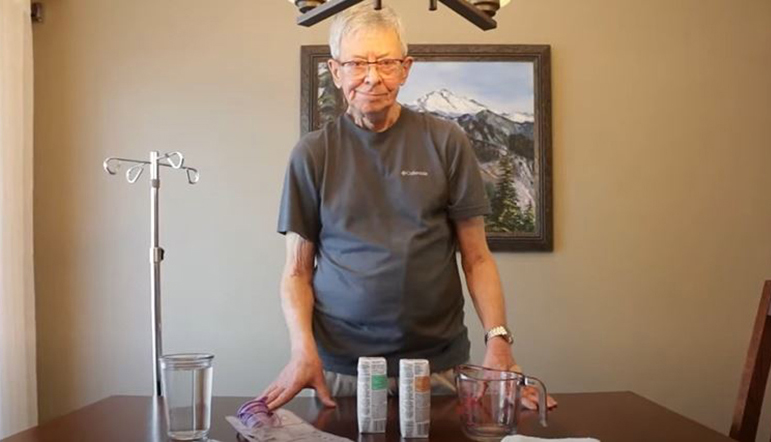
An interdisciplinary team created a series of at-home and accessible tube-feeding tutorial videos, enabling patients to take ownership over their nutrition.
Photo: John Engbers, patient partner
Nutrition is a critical part of health and can be delivered in a variety of forms. Many cancer patients or people with neurological conditions, for example, may require gastrostomy tubes because they have difficulty swallowing or are unable to eat or drink enough food to sustain a healthy caloric intake. The tubes deliver liquid food directly into their stomach, enabling them to receive necessary nutrition – protein, minerals, fluids and vitamins – to help them lead healthy lives.
When patient partner John Engbers was released from the hospital eight years ago with his new gastrostomy tube, he was initially overwhelmed with the transition to this new way of eating.
“When they show you videos in the hospital, you are still in the mindset of being a patient. However, when you are released to go home, you are independent. It was quite daunting,” reflects John. “It was so important to educate myself on all aspects of home tube-feeding, but at the time there wasn’t a lot of information available.”
In stepped registered dietitian Rebekah Sandhu and an interdisciplinary team of registered dietitians, nurse educators and patient partners like John. They noticed a gap in comprehensive and accessible resources for patients who use tube-feeding at home.
“The transitional learning for patients who use tube-feeding is quite extensive and they require a lot of support. It goes beyond just learning new tasks, but learning a new way of eating,” says Rebekah.
With funding from a Fraser Health Innovation Grant, they set out to ease the burden of making this life-changing shift and meet patients wherever they are at in their tube-feeding journeys. Their solution was to create accessible tutorial videos, filmed in a home setting.
The video’s home-based back drop was intentional. Showing how a patient navigates tube-feeding at home, using equipment that can be found around the house, enables viewers to envision how their care may look in their own homes. The intended result was to remove any clinical connotations and normalize this new form of eating while supporting viewers to take ownership over their nutrition in their own spaces.
“By providing patients the opportunity to watch the videos before and after hands-on education, they are able to review content when they need it most,” says Rebekah.
The videos, which are available on YouTube, show John modeling the three different methods of tube-feeding: feeding pump, gravity method and syringe method. By showcasing all three options in the videos, patients are able to choose which method works best for them.
“These videos will be an important tool for others to use as a reference when they go home with a feeding tube. Education and research gave me the confidence to live my life the best way I could and not feel like a patient,” says John.
Clearly others agree - the videos have been a success, with more than 13,000 collective views so far.
The team has not slowed down in its education initiative. In collaboration with Fraser Health Virtual Care, virtual care nurses now have access to educational materials that enable them to better help patients who connect for tube-feeding support.
“Food provides not only nutrition but also provides social connection with others. Re-learning how to feed yourself or a loved one requires many new skills. We hope that through education, individuals and their caregivers can feel confident as they start home tube-feeding,” says Rebekah.
